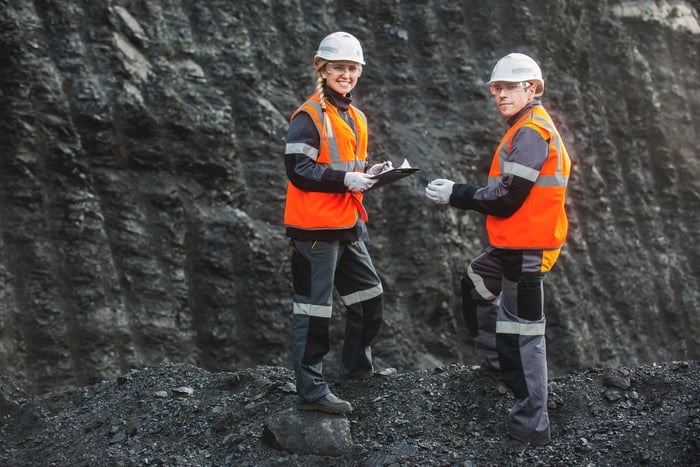Alliance Resource Partners L.P.'s (ARLP -0.85%) business is pretty easy to get your head around: It mines coal. Even though it is in the same business as other miners that have struggled mightily as of late to compete against lower-priced natural gas and alternative power sources like solar and wind, it has managed to do better than most of its peers. To understand how, and what differentiates Alliance from its rivals, you need to dig a little deeper into how it makes most of its money.
Coal mining
The basic facts of Alliance's business are simple: It digs coal out of the ground and sells it. In addition to mines, it owns a terminal facility, helping to get the coal from the mine to its customers. And its customer list is where the first important distinction for Alliance shows up. It is predominantly a thermal coal producer, meaning it's main customers are power companies. In contrast, most larger players like Peabody Energy (BTU) produce both thermal coal and metallurgical coal, which is used in the steel-making process.

Image source: Getty Images
Alliance is also domestically focused, with most of its mines located in the Illinois Basin region. Peabody has mines in Australia meant to serve the Asian market and in multiple domestic coal regions, including both the Illinois Basin and the Powder River Basin, the region where competitor Cloud Peak Energy (CLD) has all of its mines.
This, too, is a very important distinction. The Illinois Basin, which is located in what the U.S. Energy Information Administration (EIA) calls the Interior region, has been gaining market share from other domestic coal regions for years, in part because the coal there costs less to extract. This helps explain how Alliance has remained profitable through this steep coal downturn, when competitors have been bleeding red ink (like Cloud Peak) or fallen into bankruptcy (like Peabody). The EIA expects the Interior's market share to keep increasing for quite some time, going from the 20% it held in 2016 to 26% in 2040.
Some other things worth noting
To sum up, Alliance is a coal producer. But it produces a specific type of coal and largely from a single region that has been able to remain more competitive as coal broadly has lost ground to natural gas, wind and solar. And while it's in decline, coal certainly isn't dead; if the EIA is even close to correct, it will remain an important fuel source for the power grid for decades.

The EIA projects coal will continue to play a role in the electric market in even the worst case scenario.
So Alliance has plenty of time to keep throwing cash off to unitholders -- and the fact that its investors are unitholders is another key fact to keep in mind. Unlike Peabody and Cloud Peak, Alliance is a limited partnership -- a corporate structure specifically designed to pass income through to investors. The bulk of your return is likely to be in the form of distributions. Currently Alliance yields around 10%. That said, it expects to cover its distribution by roughly 1.7 times in 2017 -- a huge amount in the partnership space, where 1.2 times is considered good.
That 1.7 ratio reflects another important fact about Alliance: It's a conservatively run company, which shows up most clearly on the balance sheet. Long-term debt makes up around 25% of Alliance's capital structure. A heavy debt load is what tipped Peabody Energy into bankruptcy. Alliance's current ratio, meanwhile, is a solid 1.1. It's built on a very solid financial foundation, and that's something I wouldn't expect to change.
Simple, with nuance
In its most basic form, Alliance's coal mining business is pretty easy to grasp. But the big picture view doesn't provide the detail you need to understand the company's success in a challenged industry. You need to dig deeper to see the type of coal it mines, where it mines for that coal, and how management has positioned it financially to weather difficult times. Once you do that, you might find that owning a piece of a coal company starts to sound pretty enticing.


